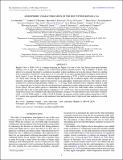| dc.contributor.author | Shporer, Avi | |
| dc.contributor.author | O'Rourke, Joseph G. | |
| dc.contributor.author | Knutson, Heather A. | |
| dc.contributor.author | Zhao, Ming | |
| dc.contributor.author | Burrows, Adam | |
| dc.contributor.author | Fortney, Jonathan J. | |
| dc.contributor.author | Agol, Eric | |
| dc.contributor.author | Cowan, Nicolas B. | |
| dc.contributor.author | Desert, Jean-Michel | |
| dc.contributor.author | Howard, Andrew W. | |
| dc.contributor.author | Isaacson, Howard | |
| dc.contributor.author | Showman, Adam P. | |
| dc.contributor.author | Todorov, Kamen O. | |
| dc.contributor.author | Lewis, Nikole | |
| dc.contributor.author | Szabo, Gyula M. | |
| dc.date.accessioned | 2015-01-22T16:20:59Z | |
| dc.date.available | 2015-01-22T16:20:59Z | |
| dc.date.issued | 2014-05 | |
| dc.date.submitted | 2014-01 | |
| dc.identifier.issn | 0004-637X | |
| dc.identifier.issn | 1538-4357 | |
| dc.identifier.uri | http://hdl.handle.net/1721.1/93123 | |
| dc.description.abstract | Kepler-13Ab (= KOI-13.01) is a unique transiting hot Jupiter. It is one of very few known short-period planets orbiting a hot A-type star, making it one of the hottest planets currently known. The availability of Kepler data allows us to measure the planet's occultation (secondary eclipse) and phase curve in the optical, which we combine with occultations observed by warm Spitzer at 4.5 μm and 3.6 μm and a ground-based occultation observation in the K[subscript s] band (2.1 μm). We derive a day-side hemisphere temperature of 2750 ± 160 K as the effective temperature of a black body showing the same occultation depths. Comparing the occultation depths with one-dimensional planetary atmosphere models suggests the presence of an atmospheric temperature inversion. Our analysis shows evidence for a relatively high geometric albedo, A [subscript g] = 0.33[+0.04 over -0.06]. While measured with a simplistic method, a high A [subscript g] is supported also by the fact that the one-dimensional atmosphere models underestimate the occultation depth in the optical. We use stellar spectra to determine the dilution, in the four wide bands where occultation was measured, due to the visual stellar binary companion 1.''15 ± 0.''05 away. The revised stellar parameters measured using these spectra are combined with other measurements, leading to revised planetary mass and radius estimates of M[subscript p] = 4.94-8.09 M [subscript J] and R[subscript p] = 1.406 ± 0.038 R [subscript J]. Finally, we measure a Kepler midoccultation time that is 34.0 ± 6.9 s earlier than expected based on the midtransit time and the delay due to light-travel time and discuss possible scenarios. | en_US |
| dc.language.iso | en_US | |
| dc.publisher | IOP Publishing | en_US |
| dc.relation.isversionof | http://dx.doi.org/10.1088/0004-637x/788/1/92 | en_US |
| dc.rights | Article is made available in accordance with the publisher's policy and may be subject to US copyright law. Please refer to the publisher's site for terms of use. | en_US |
| dc.source | American Astronomical Society | en_US |
| dc.title | ATMOSPHERIC CHARACTERIZATION OF THE HOT JUPITER KEPLER-13Ab | en_US |
| dc.type | Article | en_US |
| dc.identifier.citation | Shporer, Avi et al. “ATMOSPHERIC CHARACTERIZATION OF THE HOT JUPITER KEPLER-13Ab.” The Astrophysical Journal 788.1 (2014): 92. © 2014 The American Astronomical Society | en_US |
| dc.contributor.department | Massachusetts Institute of Technology. Department of Earth, Atmospheric, and Planetary Sciences | en_US |
| dc.contributor.mitauthor | Lewis, Nikole | en_US |
| dc.relation.journal | The Astrophysical Journal | en_US |
| dc.eprint.version | Final published version | en_US |
| dc.type.uri | http://purl.org/eprint/type/JournalArticle | en_US |
| eprint.status | http://purl.org/eprint/status/PeerReviewed | en_US |
| dspace.orderedauthors | Shporer, Avi; O'Rourke, Joseph G.; Knutson, Heather A.; Szabo, Gyula M.; Zhao, Ming; Burrows, Adam; Fortney, Jonathan; Agol, Eric; Cowan, Nicolas B.; Desert, Jean-Michel; Howard, Andrew W.; Isaacson, Howard; Lewis, Nikole K.; Showman, Adam P.; Todorov, Kamen O. | en_US |
| mit.license | PUBLISHER_POLICY | en_US |
| mit.metadata.status | Complete | |
